Submitted:
20 February 2024
Posted:
22 February 2024
You are already at the latest version
Abstract
Keywords:
1. Background and the Purpose of Research
2. Geographical and Geological Setting of Timor-Leste and the Study Area
- a)
-
Pleistocene–Holocene Suai FormationIt is mostly composed of rudites and arenites, with minor amounts of mud and marls. The particles of the formation were mostly sourced from the Viqueque Formation, Dilor Conglomerate, and Lolotoi Complex. This formation belongs to the Synorogenic Megasequence.
- b)
-
Pleistocene–Holocene Ainaro Formation (Ainaro Gravels)This formation is part of the Synorogenic Megasequence and is primarily composed of matrix-supported conglomerates that are believed to be sediments from an ancient river terrace. Occasionally, calcite lateritic cements fill these sediments, and the irregular surfaces of the river terrace sediments are frequently covered by ferruginous horizons.
- c)
-
Lower Pleistocene–Holocene Baucau Limestone (Baucau Formation)It is predominantly composed of coral reef limestones along with a minor proportion of calcarenites, calcirudites, and conglomerates (submature graywackes). This formation is expected to provide evidence of the uplift of the island. This formation belongs to the Synorogenic Megasequence.
- d)
-
Pliocene Dilor Conglomerate (Dilor Formation)This formation is part of the Synorogenic Megasequence and consists of conglomerates and sandstones with a significant contribution of detritus from the Lolotoi Complex, particularly quartzite.
- e)
-
Upper Miocene–Lower Pliocene Viqueque Formation (Synorogenic Viqueque Megasequence)Lithologically, this formation is separated into lower (described as "more clayey and silty") and upper (characterized as "more silty and sandy") sections. Large amounts of silty marls, marly siltstones, silty claystones, siltstones, and sandstones, along with minor proportions of calcilutites and biocalcarenites are present in the upper section. The lower section is mostly composed of marls, clayey marls, silty marls, claystones, silty claystones, calcilutites, and tuffs, with minor amounts of basal conglomerates and mottled marls. These rocks are mostly formed by foraminifera fossils and skeletal radiolarians as well as rock fragments and mineral particles, which are associated with carbonate, metamorphic, volcanic, and other sedimentary rocks found in the Lolotoi Complex, Maubisse Formation, Aitutu Formation, Wailuli Formation, and Bobonaro Complex. This formation is included in the Synorogenic Megasequence.
- f)
-
Middle Miocene Bobonaro Complex (Bobonaro Formation or Bobonaro Scaly-Clay or Bobonaro Mélange or Synorogenic Mélange)This unit is part of the Synorogenic Mélange and is primarily composed of exotic blocks within a scaly clay matrix. The matrix lithology is similar to that of mudstone of the Wailuli Formation. Exotic blocks of Permian to Cretaceous ages are common and widely distributed, although absent in several areas.
- g)
-
Oligocene–Miocene Cablac Limestone (Cablac Formation)This formation is largely composed of oolitic and peloidal limestones and pelagic carbonates with small amounts of intraformational conglomerates, calcilutites, calcarenites, agglomerates, and tuffaceous rocks. The most common clasts of conglomerates are volcanic rocks, calcilutites containing foraminifera, radiolarian chert, biomicarenites, and detrital minerals, such as quartz and magnetite. Several rocks have been affected by alteration processes such as dolomitization and a few have undergone partial silicification, desilicification, and dedolomitization. This formation belongs to the Banda Terrane unit.
- h)
-
Oligocene Barique FormationThis formation belongs to the Banda Terrane unit and is largely composed of mafic to acidic lavas and tuffs, with minor amounts of serpentinites, volcanic conglomerates, and sandstones. Pillow lava is also observed. Significant alterations are observed in most volcanic rocks. Volcanic rocks are considered to have formed at mid-oceanic ridges and volcanic arcs.
- i)
-
Middle–Upper Eocene Dartollu Limestone (Dartolu Formation)This limestone is part of the Banda Terrane unit and its primary constituents are algal and alveolina biomicarenites with minor proportions of calcilutites, siliceous shales, and siltstones. Dolomitization or silicification was not observed.
- j)
-
Lower–Upper Cretaceous Waibua FormationThis formation is part of the Australian-Margin Megasequence and is largely composed of radiolarites, radiolarian cherts, marls, and shales, with several percentages of calcilutites, marls, and calcarenites. Radiolaria and pelagic foraminifera are important components of these rocks and most limestones are completely or partially silicified. Radiolarian shales, marls, and radiolarites often occur in association with Mn nodules and ferromanganiferous rocks. The formation processes of radiolarites and cherts are closely associated with Mn-rich strata.
- k)
-
Late Triassic–Middle Jurassic Wailuli FormationThis formation predominantly consists of gray shales and blue-gray marls with minor amounts of sandstones, mudstones, quartz-arenites, coarse polymictic conglomerates, calcarenites, and calcilutites. Most shales are composed of fine micaceous minerals and microcrystalline carbonates. In some areas, small amounts of pyrite are present in the shales, whereas salt pseudomorphs and gypsum are present in gypsiferous shales, calcilutites, calcarenites, and quartz-arenites. Quartz-arenites contain considerable amounts of mica, and radiolarian and foraminiferal tests are the primary constituents of the calcilutites. This formation is a part of the Gondwana Megasequence.
- l)
-
Middle–Upper Triassic Aitutu FormationThis formation consists mostly of calcilutites, shales, and calcareous shales with minor amounts of marls, calcarenites, lumachelles, quartz-arenites, radiolarites, bituminous rocks, and chert. Some calcilutites include radiolarian fragments and the basal part of this formation consists of conglomerates. Radiolarian fossils are significant components of limestones but are partly or almost entirely filled with sparry calcite. Several limestones have been affected by alteration processes such as silicification, dedolomitization, and pyritization. This formation belongs to the Gondwana Megasequence.
- m)
-
Triassic–Late Cretaceous Lolotoi Complex (Lolotoi Formation or Lolotoi Metamorphic Complex)Belonging to the Banda Terrane units, this complex is composed of regionally metamorphosed sedimentary and volcanic rocks, as well as basic and ultrabasic volcanic rocks. These include greenschists, graphitic phyllites, quartz mica schists, amphibolite gneisses and schists, garnet-bearing pelitic gneisses and schists, metagabbros, granulites, garnet mica schists, mafic and felsic igneous, pelitic schists, metabasite schists, carbonate-rich greenschists, peridotites, blueschists, serpentinites, and pyroxenites. The metamorphic rocks of the Lolotoi Complex mostly originate from sedimentary rocks and some metavolcanic rocks have undergone considerable alteration. The forearc region is thought to have been the location of the deposition of sedimentary rocks, and the rock components are thought to have originated from intermediate to mafic continental and oceanic arcs. Volcanic rocks were formed at volcanic arcs and mid-oceanic ridges.
- n)
-
Permian–Triassic Maubisse Formation (Maubisse Limestone)This formation belongs to the Gondwana Megasequence and is mainly composed of fossiliferous limestones and volcanic rocks, as well as other types of sedimentary rocks. These include well-bedded dense biocalcarenites, massive reef limestones, pink crinoidal limestones, calcirudites, sandstones, calcareous shales, micaceous siltstones, tuffs, volcanic conglomerates, basalts, marbles, and metamorphosed basic volcanics. The basalts are pillowed and amygdaloidal and have an alkaline chemical composition. Alteration processes have affected most rocks of the Maubisse Formation, and limestones have been partially affected by alteration processes such as silicification, dolomitization, and chloritization.
3. Sampling and Analytical Methods
3.1. Sampling Method
3.2. Analytical Method
3.3. Statistical Analysis
4. Analytical Results
4.1. Geochemical Features of River Sand Samples
4.2. Comparison with UCC and PAAS
4.3. Geochemical Characteristics of Some Drainage Basins
- 1)
-
Soin River catchmentAs shown in Table 2A, showed a positive correlation with , , , and , as opposed to , which was negatively associated with and and positively correlated with all other major elements. had a strong positive association with and a negative relationship with all other elements. Positive relationships were observed between , , , , , and . These findings suggest that silicate, heavy, and accessory minerals (such as quartz, plagioclases, amphiboles, ilmenites, rutiles, garnets, apatites, sphenes, muscovites, and chlorites) as well as calcium carbonate, manganese, mica, and clay minerals contributed to the composition of river sand samples in this river catchment.The highest observed amounts of , , , , , , , and , along with the lowest measured concentrations of and , were mostly recorded near the upstream areas. The midstream regions had the lowest observed content and the highest measured concentrations of , , and . In addition, the downstream regions had the highest content, high concentrations of and , and low concentrations of , , , , and . This indicated that the upstream areas were mostly influenced by clay and mica content as well as quartz, plagioclase, amphibole, chlorite, hematite, ilmenite, rutile, garnet, sphene, and apatite minerals, which are associated with siliciclastic sedimentary and metamorphic rocks. Carbonate components and Mn minerals affiliated with calcareous sedimentary rocks, along with the clay content associated with shales and mudstones, made major contributions to the midstream regions. The downstream regions were mostly controlled by silicate minerals, such as quartz associated with siliceous sedimentary rocks, carbonate components, and manganese minerals affiliated with carbonaceous sedimentary rocks, along with clay content related to shales and mudstones.
- 2)
-
Laclo do Sul River catchmentAs shown in Table 2B, was positively correlated with , , , and . was positively associated with , , , , , and . Moderate-to-very strong correlations were observed between , , , , and . These results suggested the major contributions of clay and mica minerals, along with silicate, heavy, and accessory minerals (such as quartz, plagioclase, feldspar, amphibole, pyroxene, biotite, ilmenite, hematite, sphene, rutile, and garnet), which significantly contributed to the geochemical composition of the river sand samples from this river catchment.The concentration appeared to increase in the upstream direction. High , , , , , , , and contents and low and concentrations were recorded near the upstream areas. Downstream and midstream regions, specifically sample location SS045, had high concentrations of , , , and and low and contents. In addition, high values of , , and , along with low concentrations of , , and , were also observed in the downstream area. The destruction of clay and mica, along with quartz, plagioclase, amphibole, chlorite, hematite, ilmenite, rutile, garnet, sphene, and apatite minerals associated with siliciclastic sedimentary and metamorphic rocks, contributed significantly to the composition of the river sands near the upstream regions. Near the downstream and continuing to the midstream regions, quartz and clay contents affiliated with shales and mudstones made major contributions; however, there were significant inputs from mafic and heavy minerals associated with igneous and metamorphic rocks at sample location SS045. Silicate minerals and clay related to sedimentary rocks contributed significantly to the downstream area.
- 3)
-
Clerec River catchmentAs demonstrated by the Pearson correlation of the Clerec River catchment (Table 2C), showed a positive association with and , had a positive correlation with , , , , and , and showed a positive correlation with , , and . There was a moderate-to-very strong positive relationship between , , , , and , indicating that the destruction of clay, mica, amphibole, pyroxene, biotite, ilmenite, hematite, sphene, rutile, garnet, and apatite, along with calcium carbonate, manganese, and alteration minerals, contributed significantly to the composition of the river sand from this river catchment. The positive correlations between , , and indicated that they may have been derived from the same source. The elevated level may be related to the presence of secondary K-bearing minerals.The content tended to increase downstream; however, the highest measured concentration in this river catchment was recorded at the sample site SS049. In the midstream regions, high contents of , , and and the lowest concentrations of and were recorded. The reported distribution of the elemental concentrations near the downstream regions showed high measured values of , , , , , and . In contrast, elevated values of , , and were recorded at sample site SS049. The downstream regions also appeared to have high concentrations of , , and and low and contents. These findings suggest that the midstream areas were largely influenced by quartz, clay, and mica contents as well as lithic fragments, which are associated with siliciclastic sedimentary rocks. Near the downstream regions, clay, muscovite, quartz, plagioclase, chlorite, sphene, garnet and apatite minerals affiliated with siliciclastic sedimentary rocks and their altered rocks owing to metamorphic processes made major contributions. However, sample location SS049 was characterized by notable inputs from quartz, calcium carbonate, manganese, and secondary K-bearing minerals, which were associated with altered carbonate rocks intercalated with shales due to silicification processes. In addition, there were major contributions from silicate and clay contents related to sedimentary rocks in the downstream areas.
- 4)
-
Sahe River catchmenthad a positive correlation with and and showed a very strong association with and they had a moderate-to-strong positive relationship with , , and (Table 2D). Positive associations were observed between , , , , , and . These findings indicated that there were inputs of calcium carbonate, clay, muscovite, manganese, quartz, plagioclase, feldspar, amphibole, biotite, chlorite, ilmenite, hematite, rutile, garnet, sphene, and apatite. The presence of in carbonate rocks associated with Mn minerals is not common. could be associated with Mn minerals in carbonate rocks, suggesting the presence of secondary Ti-bearing minerals owing to certain alteration processes.In this river catchment, the highest concentrations of and appeared in areas near the upstream regions, along with the lowest concentrations of , , , , and . Although high measured concentrations of , , and were reported in the midstream regions, sample location SS015 also appeared to have high measured contents of and and low concentrations of , , , and . The downstream regions were also reported to have high , , , , and contents. This indicate that the composition of the river sand sample near the upstream area and sample location SS013 was mostly controlled by the destruction of quartz, clay, and mica minerals, which were affiliated with siliciclastic sedimentary rocks; however, silicate and accessory minerals (such as quartz, muscovite and garnet minerals), which are associated with their altered rocks due to metamorphic processes, contributed to the sample location SS013. Sample sites SS014 and SS015 had contributions from calcium-carbonate minerals associated with carbonate rocks; however, there were notable inputs from quartz and secondary K-bearing minerals affiliated with altered carbonate rocks intercalated with shales strata due to silicification processes in the sample location SS014, and considerable contributions to SS015 came from calcium carbonate, manganese, and Ti-bearing minerals, which were also associated with altered carbonate rocks intercalated with shales strata due to certain alteration processes. The downstream regions were characterized by contributions from quartz, clay, carbonate, mica, amphibole, chlorite, ilmenite, garnet, and other minerals related to sedimentary rocks.
5. Discussion
5.1. Relationship between River Sand Geochemistry and Provenance Geology
5.2. PCA
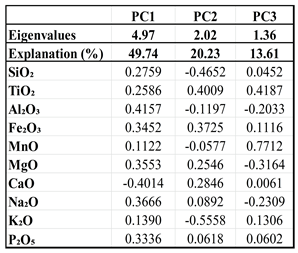 |
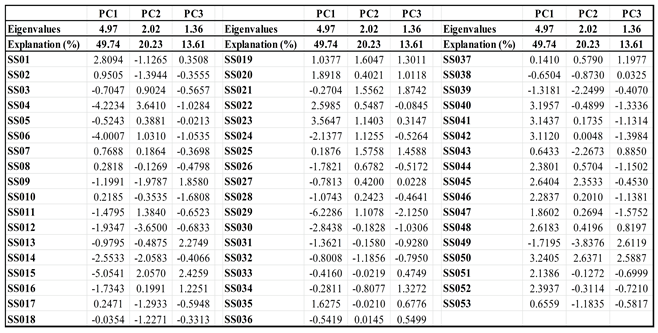 |
6. Conclusion
Author Contributions
Funding
Acknowledgments
Conflicts of Interest
Abbreviations
| PCA | Principal component analysis |
| PC1 | Principal component 1 |
| PC2 | Principal component 2 |
| PC3 | Principal component 3 |
| ICV | Index of compositional variability |
| XRF | X-ray fluorescence |
| UCC | Upper continental crust |
| PAAS | Post-Archean Australian Shale |
| Mn | Manganese |
| K-bearing minerals | Potassium-bearing minerals |
| Ti-bearing minerals | Titanium-bearing minerals |
| JMP | Jump, statistical analysis software developed by JMP |
| ArcGIS | Aeronautical Reconnaissance Coverage Geographic Information System |
| JICA | Japan International Cooperation Agency |
References
- Audley-Charles, M. G. The Geology of Portuguese Timor. Memoirs of the Geological Society of London 1968, 4, 1–75. [Google Scholar]
- Audley-Charles, M. G. Tectonic Post-Collision Processes in Timor. The Geological Society of London, Special Publication 2011, 355, 241–266. [Google Scholar] [CrossRef]
- Audley-Charles, M. G., Carter, D. J., & Barber, A. J. Stratigraphic Basis for Tectonic Interpretation of the Outer Banda Arc, Eastern Indonesia. Proceeding Indonesian Petroleum Association, Indonesia, Third Annual Convention, June 1974, 25–44.
- Audley-Charles, M. G., & Carter, D. J. Tectonic Post-Collision Processes in Timor. Palaeogeographical Significance of Some Aspect of Palaeogene and Early Neogene Stratigraphy and Tectonics of the Timor Sea Region. 1972, 11, 247–264.
- Bachri, S., & Situmorang, R. L. Peta Geologi Lembar Dili, Timor Timur, Skala 1: 250.000. Pusat Penelitian dan Pengembangan Geologi, 1994.
- Barber, A. J.; Audley-Charles, M. G. The Significance of the Metamorphic Rocks of Timor in the Development of the Banda Arc, Eastern Indonesia. Tectonophysics 1976, 30, 119–128. [Google Scholar] [CrossRef]
- Boger, S. D., Spelbrink, L. G., Lee, R. I., Sandiford, M., Maas, R., & Woodhead, J. D. Isotopic (U-Pb, Nd) and Geochemical Constraints on the Origins of the Aileu and Gondwana Sequences of Timor. Journal of Asian Earth Sciences 2017, 134, 330–351. [CrossRef]
- Charlton, T. R. Stratigraphic Correlation Across an Arc-Continent Collision Zone: Timor and the Australian Northwest Shelf. Australian Journal of Earth Sciences 1989, 36, 263–274. [Google Scholar] [CrossRef]
- Charlton, T. R. Post-Collision Extension in Arc-Continent Collision Zones, Eastern Indonesia. Geology 1991, 19(1), 28–31. [Google Scholar] [CrossRef]
- Charlton, T. R. The Structural Setting and Tectonic Significance of the Lolotoi, Laclubar and Aileu Metamorphic Massifs, East Timor. Journal of Asian Earth Sciences 2002, 20, 851–865. www.elsevier.com/locate/jseaes. [CrossRef]
- Charlton, T. R., Barber, A. J., Harris, R. A., Barkham, S. T., Bird, P. R., Archbold, N. W., Morris, N. J., Nicoll, R. S., Owen, H. G., Owens, R. M., Sorauf, J. E., Taylor, P. D.,Webster, G. D.; Whittaker, J. E. The Permian of Timor: Stratigraphy, Palaeontology and Palaeogeography. Journal of Asian Earth Sciences 2002, 20, 719–774. www.elsevier.com/locate/jseaes.
- Charlton, T. R., Barber, A. J., McGowan, A. J., Nicoll, R. S., Roniewicz, E., Cook, S. E., Barkham, S. T., & Bird, P. R. The Triassic of Timor: Lithostratigraphy, Chronostratigraphy and Palaeogeography. Journal of Asian Earth Sciences 2009, 36(4-5, 341–363. [CrossRef]
- Ely, K. S., Sandiford, M., Hawke, M. L., Phillips, D., Quigley, M., & Reis, J. E. dos. Evolution of Ataúro Island: Temporal constraints on subduction processes beneath the Wetar zone, Banda Arc. Journal of Asian Earth Sciences 2011, 41(6), 477–493. [CrossRef]
- Haig, D. W. Palaeobathymetric Gradients Across Timor During 5.7 - 3.3 Ma (Latest Miocene-Pliocene) and Implications for Collision Uplift. Palaeogeography, Palaeoclimatology, Palaeoecology 2012, 331-332, 50–59. [Google Scholar] [CrossRef]
- Haig, D. W., McCartain, E., Barber, L., Backhouse, J. Triassic - Lower Jurassic Foraminiferal Indices for Bahaman - Type Carbonate - Bank Limestones, Cablac Mountain, East Timor. Journal of Foraminiferal Research, 2007; 37, 248–264. [CrossRef]
- Haig, D. W., McCartain, E. W., Keep, M., Barber, L. Re-evaluation of the Cablac Limestone at Its Type Area, East Timor: Revision of the Miocene Stratigraphy of Timor. Journal of Asian Earth Sciences 2008, 33(5–6), 366–378. [CrossRef]
- Haig, D. W., Mossadegh, Z. K., Parker, J. H., & Keep, M. Middle Eocene neritic limestone in the type locality of the volcanic Barique Formation, Timor-Leste: Microfacies, age and tectonostratigraphic affinities. Journal of Asian Earth Sciences 2019, X, 1. [CrossRef]
- Harris, R. A. Rise and Fall of the Eastern Great Indonesian Arc Recorded by the Assembly, Dispersion and Accretion of the Banda Terrane, Timor. Gondwana Research 2006, 10(3–4), 207–231. [CrossRef]
- Harris, R. A. The Nature of the Banda Arc - Continent Collision in the Timor Region. Arc-Continent Collision, Frontiers in Earth Sciences 2011, 4, 163–211. [Google Scholar] [CrossRef]
- Keep, M., Haig, D. W. Deformation and Exhumation in Timor: Distinct Stages of a Young Orogeny. Tectonophysics 2009, 483(1–2), 93–111. Tectonophysics. [CrossRef]
- Leme, J. C. A. Breve Ensaio Sobre a Geologia da Província de Timor. Junta de Investigações do Ultramar, Geólogo da Missão de Estudos Agronómicos do Ultramar 1968, 1, 106–161. [Google Scholar]
- Lisboa, J. V. V., Silva, T. P., De Oliveira D. P. S, & Carvalho, J. F. Mineralogical and Geochemistry Characteristics of the Bobonaro Melange of Western East Timor: Provenance Implications. Comunicações Geológicas 2020, 106(I), 35–49. https://www.lneg.pt/wp-content/uploads/2020/05/Volume_106.pdf.
- Park, S.-I., Kwon, S., & Kim, S. W. Evidence for the Jurassic Arc Volcanism of the Lolotoi complex, Timor: Tectonic Implications. Journal of Asian Earth Sciences 2014, 95, 254–265. [CrossRef]
- Partoyo, E., Hermanto, B., & Bachri, S. Peta Geologi Lembar Baucau, Timor Timur, Skala 1: 250.000. Pusat Penelitian dan Pengembangan Geologi., 1995.
- Standley, C. E., & Harris, R. Tectonic Evolution of Forearc Nappes of the Active Banda Arc - Continent Collision: Origin, Age, Metamorphic History and Structure of the Lolotoi Complex, East Timor. Tectonophysics 2009, 479(1-2), 66–94. [CrossRef]
- Wittouck, S. F. Exploration of Portuguese Timor. Report of Allied Mining Corporation to Asia Investment Company, Limited 1937.
- Audley-Charles, M. G. The Geology of Portuguese Timor. Doctor Thesis, University of London, London–England, March 1965.
- Barber, A. J., Audley-Charles, M. G., Carter, D. J. Thrust Tectonics in Timor. Journal of the Geological Society of Australia 1977, 24, 51–62. [CrossRef]
- Carter, D. J., Audley-Charles, M. G., & Barber, A. J. Stratigraphical Analysis of Island Arc - Continental Margin Collision in Eastern Indonesia. The Journal of Geological Society of London 1976, 132, 179–198.
- Grady, A. E., Berry, R. F. Some Palaeozoic - Mesozoic Stratigraphic - Structural Relationships in East Timor and Their Significance in the Tectonics of Timor. Journal of the Geological Society of Australia 1977, 24, 203–214. [CrossRef]
- Harris, R.A.; Long, T. The Timor Ophiolite, Indonesia: Model or Myth? Geological Society of America 2000, 349, 321–330. [Google Scholar]
- Bineli, M. T. N., Onana, V. L., Noa Tang, S. D., Bikoy, Y. R., & Ekodeck, G. E. Mineralogy and geochemistry of sands of the lower course of the Sanaga River, Cameroon: implications for weathering, provenance, and tectonic setting. Acta Geochimica 2021, 40(3), 348–365. [CrossRef]
- Brundin, N.H.; Nairis, B. Alternative Sample Types in Regional Geochemical Prospecting. Journal of Geochemical Exploration 1972, 1, 7–46. [Google Scholar] [CrossRef]
- Franzinelli, E.; Potter, P. E. Petrology, Chemistry, and Texture of Modern River Sands, Amazon River System. Journal of Geology 1983, 91, 23–39. [Google Scholar] [CrossRef]
- Liyouck, P. R., Ngueutchoua, G., Armstrong-Altrin, J. S., Sonfack, A. N., Kontchipe Ngagoum, Y. S., Ekoa Bessa, A. Z., Ambassa Bela, V., Tsanga, D. A., & Wouatong, A. S. L. Petrography and geochemistry of the Sanaga river sediments, central Cameroon: Constraints on weathering, provenance, and tectonic setting. Journal of African Earth Sciences, 199, 104840 2023, 199 (104840). [CrossRef]
- Nesbitt, H. W., Young, G. M. Petrogenesis of sediments in the absence of chemical weathering: Effects of abrasion and sorting on bulk composition and mineralogy. Sedimentology 1996, 43, 341–358. [CrossRef]
- Nurmi, P.A.; Isohanni, M. Rock, Till, and Stream Sediment Geochemistry in the Search for Porphyry-Type Mo-Cu-Au Deposit in the Proterozoic Rautio Batholith, Western Finland. Journal of Geochemical Exploration 1984, 20, 209–228. [Google Scholar] [CrossRef]
- Ortiz, E.; Roser, B.P. Geochemistry of Stream Sediments from the Hino River, SW Japan: Source Rock Signatures, Downstream Compositional Variations, and Influence of Sorting and Weathering. Earth Science (Chikyu Kagaku) 2006, 60, 131–146. [Google Scholar]
- Ortiz, E., & Roser, B. P. Major and trace element provenance signatures in stream sediments from the Kando River, San’in district, southwest Japan. Island Arc 2006b, 15(2), 223–238. [CrossRef]
- Rahman, M. A., Das, S. C., Pownceby, M. I., Tardio, J., Alam, M. S., & Zaman, M. N. Geochemistry of Recent Brahmaputra River Sediments: Provenance, Tectonics, Source Area Weathering and Depositional Environment. Minerals 2020, 10(9), 1–30. [CrossRef]
- Ranasinghe, P. N., Fernando, G. W. A. R., Dissanayake, C. B., & Rupasinghe, M. S. Stream Sediment Geochemistry of the Upper Mahaweli River Basin of Sri Lanka-Geological and Environmental Significance. Journal of Geochemical Exploration, 99(1–3), 1–28 2008, 99(1-3), 1–28. [CrossRef]
- Yamamoto, K., Tanaka, T., Minami, M., Mimura, K., Asahara, Y., Yoshida, H., Yogo, S., Takeuchi, M., Inayoshi, M. Geochemical Mapping in Aichi Prefecture, Japan: Its Significance as a Useful Dataset for Geological Mapping. Applied Geochemistry 2007, 22, 306–319. [CrossRef]
- Young, S. M., Pitawala, A., Ishiga, H. Geochemical Characteristics of Stream Sediments, Sediment Fractions, Soils, and Basement Rocks from the Mahaweli River and Its Catchment, Sri Lanka. Chemie Der Erde 2013, 73, 357–371. [CrossRef]
- Pan, T., Zuo, R., & Wang, Z. Geological Mapping via Convolutional Neural Network Based on Remote Sensing and Geochemical Survey Data in Vegetation Coverage Areas. IEEE Journal of Selected Topics in Applied Earth Observations and Remote Sensing 2023, 16, 3485–3494. [CrossRef]
- Audley-Charles, M. G. Geometrical Problems and Implications of Large-Scale Over-Thrusting in the Banda Arc - Australian Margin Collision Zone. The Geological Society of London 1981, 407–416. [Google Scholar] [CrossRef]
- Audley-Charles, M. G. Rates of Neogene and Quaternary Tectonic Movements in the Southern Banda Arc Based on Micropalaeontology. Journal of the Geological Society, London 1986, 143, 161–175. [Google Scholar] [CrossRef]
- Audley-Charles, M. G. Ocean Trench Blocked and Obliterated by Banda Forearc Collision with Australian Proximal Continental Slope. Tectonophysics 2004, 389, 65–79. [CrossRef]
- Barber, A. J. Structural Interpretations of the Island of Timor, Eastern Indonesia. The Geology and Tectonics of Eastern Indonesia, Geological Research and Development Centre 1981, 2, 183–197. [Google Scholar]
- Berry, R.F.; Grady, A.E. Deformation and Metamorphism of the Aileu Formation, North Coast, East Timor and Its Tectonic Significance. Journal of Structural Geology 1981, 3, 143–167. [Google Scholar] [CrossRef]
- Berry, R.F.; Jenner, G.A. Basalt Geochemistry as a Test of the Tectonic Models of Timor. Journal of Geological Society of London 1982, 139, 593–604. [Google Scholar] [CrossRef]
- Charlton, T. R. Tertiary Evolution of the Eastern Indonesia Collision Complex. Journal of Asian Earth Sciences 2000, 18, 603–631. [Google Scholar] [CrossRef]
- Duffy, B., Quigley, M., Harris, R., & Ring, U. Arc - Parallel Extrusion of the Timor Sector of the Banda Arc - Continent Collision. Tectonics 2013, 32(3), 641–660. [CrossRef]
- Duffy, B., Kalansky, J., Bassett, K., Harris, R., Quigley, M., van Hinsbergen, D. J. J., Strachan, L. J., & Rosenthal, Y. Mélange Versus Forearc Contributions to Sedimentation and Uplift, During Rapid Denudation of a Young Banda Forearc-Continent Collisional Belt. The Journal of Asian Earth Sciences 2017, 138, 186–210. [CrossRef]
- Haig, D. W., Rigaud, S., McCartain, E., Martini, R., Barros, I. S., Brisbout, L., Soares, J., & Nano, J. Upper Triassic carbonate-platform facies, Timor-Leste: Foraminiferal indices and regional tectonostratigraphic association. Palaeogeography, Palaeoclimatology, Palaeoecology 2021, 570, 241–266. [CrossRef]
- Harris, R. A., Kaiser, J., Hurford, A., & Carter, A. Thermal History of Australian Passive Margin Cover Sequences Accreted to Timor During Late Neogene Arc - Continent Collision, Indonesia. Journal of Asian Earth Sciences 2000, 18, 47–69.
- Harris, R. A., Vorkink, M. W., Prasetyadi, C., Zobell, E., Roosmawati, N., & Apthorpe, M. Transition from Subduction to Arc-Continent Collision: Geologic and Neotectonic Evolution of Savu Island, Indonesia. Geosphere 2009, 5, 152–171. [CrossRef]
- Kaneko, Y., Maruyama, S., Kadarusman, A., Ota, T., Ishikawa, M., Tsujimori, T., Ishikawa, A., Okamoto, K. On-Going Orogeny in The Outer-Arc of the Timor-Tanimbar Region, Eastern Indonesia. Gondwana Research2007, 11, 218–233. [CrossRef]
- Price, N. J., & Audley-Charles, M. G. Tectonic Collision Processes After Plate Rupture. Tectonophysics 1987, 140, 121–129.
- Tate, G. W., McQuarrie, N., Van Hinsbergen, D. J. J., Bakker, R. R., Harris, R., Willett, S., Reiners, P. W., Fellin, M. G., Ganerød, M., & Zachariasse, W. J. Resolving Spatial Heterogeneities in Exhumation and Surface Uplift in Timor-Leste: Constraints on Deformation Processes in Young Orogens. Tectonics 2014, 33(6), 1089–1112. [CrossRef]
- Tate, G. W., McQuarrie, N., Van Hinsbergen, D. J. J., Bakker, R. R., Harris, R., & Jiang, H. Australia Going Down Under: Quantifying Continental Subduction During Arc-Continent Accretion in Timor-Leste. Geosphere 2015, 11(6), 1860–1883. [CrossRef]
- Tate, G. W., McQuarrie, N., Tiranda, H., van Hinsbergen, D. J. J., Harris, R., Zachariasse, W. J., Fellin, M. G., Reiners, P. W., & Willett, S. D. Reconciling Regional Continuity with Local Variability in Structure, Uplift and Exhumation of the Timor Orogen. Gondwana Research 2017, 49, 364–386. [CrossRef]
- Audley-Charles, M. G., & Harris, R. Allochthonous Terranes of the Southwest Pacific and Indonesia. Philosophical Transactions of the Royal Society of London 1990, 331(1620), 571–587.
- Keep, M., Barber, L., Haig, D. Deformation of the Cablac Mountain Range, East Timor: an Overthrust Stack Derived from an Australian Continental Terrace. Journal of Asian Earth Sciences 2009, 35, 150–166. [CrossRef]
- Audley-Charles, M. G. Paleoenvironmental Significance of Chert in the Franciscan Formation of Western California: Discussion Concerning the Significance of Chert in Timor. Geological Society of America Bulletin 1973, 84(2), 363–368. [Google Scholar] [CrossRef]
- Barber, A. J., Tjokrosapoetro, S., & Charlton, T. R. Mud Volcanoes, Shale Diapirs, Wrench Faults, and Melanges in Accretionary Complexes, Eastern Indonesia. The American Association of Petroleum Geologists 1986, 70, 1729–1741.
- Charlton, T. R., & Wall, D. New Biostratigraphic Results from the Kolbano Area, Southern West Timor: Implications for the Mesozoic-Tertiary Stratigraphy of Timor. Journal of Southeast Asian Earth Sciences 1994, 9, 113–122.
- Earle, M. The Metamorphic Rocks of Boi, Timor, Eastern Indonesia. The Geology and Tectonics of Eastern Indonesia, Geological Research and Development Centre 1981, 2, 239–251, https://www.researchgate.net/ publication/285976880. [Google Scholar]
- Haig, D. W., McCartain, E., Mory, A. J., Borges, G., Davydov, V. I., Dixon, M., Ernst, A., Groflin, S., Håkansson, E., Keep, M., Santos, Z. Dos, Shi, G. R., & Soares, J. Postglacial Early Permian (late Sakmarian-early Artinskian) shallow-marine carbonate deposition along a 2000km transect from Timor to west Australia. Palaeogeography, Palaeoclimatology, Palaeoecology 2014, 409, 180–204. [CrossRef]
- Haig, D. W., McCartain, E. Carbonate Pelagites in the Post-Gondwana Succession (Cretaceous - Neogene) of East Timor. Australian Journal of Earth Sciences 2007, 54, 875–897. [CrossRef]
- Haig, D. W., & McCartain, E. Triassic Organic - Cemented Siliceous Agglutinated Foraminifera from Timor Leste: Conservative Development in Shallow - Marine Environments. Journal of Foraminiferal Research 2010, 40, 366–392.
- Harris, R.A. Temporal Distribution of Strain in the Active Banda Orogen: a Reconciliation of Rival Hypotheses. Journal of Southeast Asian Earth Sciences 1991, 6, 373–386. [Google Scholar] [CrossRef]
- Harris, R. A., Sawyer, R. K., & Audley-Charles, M. G. Collisional Melange Development: Geologic Associations of Active Melange-Forming Processes with Exhumed Melange Facies in the Western Banda Orogen, Indonesia. Tectonics 1998, 17, 458–479.
- Kenyon, C. S. Stratigraphy and Sedimentology of the Late Miocene to Quaternary Deposits of Timor. Doctor Thesis, University of London, London–England, May 1974.
- Hale, M., & Plant, J. A. Introduction: The Foundation of Modern Drainage Geochemistry. In Handbook of Exploration Geochemistry: Drainage Geochemistry; Govett, G. J. S, Elsevier Science B.V; Amsterdam, Netherlands, 1994; pp. 3–9.
- Darnley, A. G., Bjorklund, A., Bolviken, B., Gustavsson, N., Koval, P. V., Plant, J. A., Steenfelt, A., Tauchid, M., Xuejing, X., Garrett, R. G., & Hall, G. E. M. A Global Geochemical Reference Network & Field Methods for Regional Surveys. In A Global Geochemical Database for Environmental and Resource Management: Recommendations for International Geochemical Mapping; United Nations Educational, Scientific and Cultural Organization (UNESCO); Publishing House: Paris, France, 1995; pp. 37–53.
- Tanaka, T., Kawabe, I., Yamamoto, K., Iwamori, H., Hirahara, Y., Mimura, K., Asahara, Y., Ito, T., Yonezawa, C., Dragusanu, C., Kanda, S., Shimizu, O., Hayashi, M., Miura, N., Aoki, H., Ohta, A., Togami, K., Toriumi, T., Matsumura, Y., Sakakibara, T., Tanimizu, M., Mizutani, Y., Miyanaga, N., Murayama, M., & Ohmori, F. Distributions of Elements in Stream Sediments in and around Seto City, Aichi Prefecture: An Attempt to a Geoenvironmental Assessment by Geochemical Mapping. Geochemistry 1995, 29, 113–125.
- Fletcher, W. K. Stream Sediment Geochemistry in Today´s Exploration World. Proceedings of Exploration 97: Fourth Decennial International Conference on Mineral Exploration. In A. G. Gubins (Ed.), 1997, pp 249-–260.
- Ohta, A., Imai, N., Terashima, S., & Tachibana, Y. Application of Multi-Element Statistical Analysis for Regional Geochemical Mapping in Central Japan. Applied Geochemistry 2005, 20(5), 1017–1037. [CrossRef]
- Yamamoto, K., & Morishita, T. Preparation of Standard Composites for the Trace Elements Analysis by X-Ray Fluorescence. Geological Society of Japan 1997, 103, 1037–1045.
- Rudnick, R. L., & Gao, S. Composition of the Continental Crust. In Treatise on Geochemistry; Holland, H. D., & Turekian, K. K.; USA, 2003; Volume I, pp. 1–64. [CrossRef]
- Taylor, S. R., & McLennan, S. M. The Continental Crust: Its Composition and Evolution; Blackwell Scientific Publications, Oxford, UK, 1985.
- Demšar, U., Harris, P., Brunsdon, C., Fotheringham, A. S., & McLoone, S. Principal Component Analysis on Spatial Data: An Overview. Annals of the Association of American Geographers 2013, 103(1), 106–128. [CrossRef]
- Reimann, C., Filzmoser, P., Garrett, R. G., & Dutter, R. Principal Component Analysis (PCA) and Factor Analysis (FA). In Statistical Data Analysis Explained: Applied Environmental Statistics with R; John Wiley & Sons, Ltd.; West Sussex, England, 2008; pp. 211–232.
- Biswas, P. K., Alam, M. S., Hasan, A. S. M. M., Ahmed, S. S., & Zaman, M. N. Geochemical signatures of recent bar deposits in the Tista river, Bangladesh: Implications to provenance, paleoweathering and tectonics. Journal of Nepal Geological Society 2020, 60, 1–20. [CrossRef]
- He, M., Zheng, H., Clift, P. D., Tada, R.,Wu,W., Luo, C. Geochemistry of fine-grained sediments in the Yangtze River and the implications for provenance and chemical weathering in East Asia. Progress in Earth and Planetary Science 2015, 2. [CrossRef]
- Hossain, H. M. Z. Major, trace, and REE geochemistry of the Meghna River sediments, Bangladesh: Constraints on weathering and provenance. Geological Journal 2020, 55(5), 3321–3343. [Google Scholar] [CrossRef]
- Kimeli, A., Ocholla, O., Okello, J., Koedam, N., Westphal, H., & Kairo, J. Geochemical and petrographic characteristics of sediments along the transboundary (Kenya-Tanzania) Umba River as indicators of provenance and weathering. Open Geosciences 2021, 13(1), 1064–1083. [CrossRef]
- Kontchipe, Y. S. N., Sopie, F. T., Ngueutchoua, G., Sonfack, A. N., Nkouathio, D. G., Tchatchueng, R., Nguemo, G. R. K., & Njanko, T. Mineralogy and Geochemistry Study of the Nyong River Sediments, SW Cameroon: Implications for Provenance, Weathering, and Tectonic Setting. Arabian Journal of Geosciences 2021, 14(1018), 1–26.
- Sonfack, A. N., Ngueutchoua, G., Kontchipe, Y. S. N., Sopie, F. T., Nkouathio, D. G., Wouatong, A. S. L., Tchatchueng, R., Kenfack Nguemo, G. R., & Njanko, T. Mineralogical and Geochemical Signatures of Surface Stream Sediments from Dibamba River Basin, SW Cameroon: Implications for Provenance, Weathering, and Tectonic Setting. Journal of African Earth Sciences 2011, 181, 1–26. [CrossRef]
- Cox, R., Lowe, D. R., & Cullers, R. L. The Influence of Sediment Recycling and Basement Composition on Evolution of Mudrock Chemistry in the Southwestern United States. Geochimica et Cosmochimica Acta 1995, 59(14), 2919–2940. [CrossRef]
- Zuffa, G. G. Unravelling Hinterland and Offshore Palaeogeography from Deep-water Arenites. Marine Clastic Seimentology 1987, 39–61. [Google Scholar]
- McLennan, S. M., Hemming, S., McDaniel, D. K., & Hanson, G. N. Geochemical Approaches to Sedimentation, Provenance, and Tectonics. Geological Society of America 1993, 284, 21–40. [CrossRef]
- Herron, M. M. Geochemical Classification of Terrigenous Sands and Shales from Core or Log Data. Sedimentary Petrology 1988, 58(5), 820–829. [CrossRef]
- Pettijohn, F. J., Potter, P. E., & Siever, R. Sand and Sandstone; Springer - Verlag; New York, USA, January 1972; pp. 1–618. [CrossRef]
- Roser, B. P., Cooper, R. A., Nathan, S., & Tulloch, A. J. Reconnaissance Sandstone Geochemistry, Provenance, and Tectonic Setting of the Lower Paleozoic Terranes of the West Coast and Nelson, New Zealand. New Zealand Journal of Geology and Geophysics 1996, 39(1), 1–16. [CrossRef]
- Armstrong-Altrin, J. S., Nagarajan, R., Madhavaraju, J., Rosalez-Hoz, L., Lee, Y. Il, Balaram, V., Cruz-Martínez, A., & Avila-Ramírez, G. Geochemistry of the Jurassic and Upper Cretaceous Shales from the Molango Region, Hidalgo, Eastern Mexico: Implications for Source-Area Weathering, Provenance, and Tectonic Setting. Comptes Rendus - Geoscience 2013, 345(4), 185–202. [CrossRef]
- Armstrong-Altrin, J. S., Botello, A. V., Villanueva, S. F., & Soto, L. A. Geochemistry of Surface Sediments from the Northwestern Gulf of Mexico: Implications for Provenance and Heavy Metal Contamination. Geological Quarterly 2019, 63(3), 522–538. [CrossRef]
- Kassi, A. M., Grigsby, J. D., Khan, A. S., & Kasi, A. K. Sandstone Petrology and Geochemistry of the Oligocene-Early Miocene Panjgur Formation, Makran Accretionary Wedge, Southwest Pakistan: Implications for Provenance, Weathering and Tectonic Setting. Journal of Asian Earth Sciences 2015, 105, 192–207. [CrossRef]
- Armstrong-Altrin, J. S. Detrital zircon U–Pb geochronology and geochemistry of the Riachuelos and Palma Sola beach sediments, Veracruz State, Gulf of Mexico: a new insight on palaeoenvironment. Journal of Palaeogeography 2020, 9. [CrossRef]
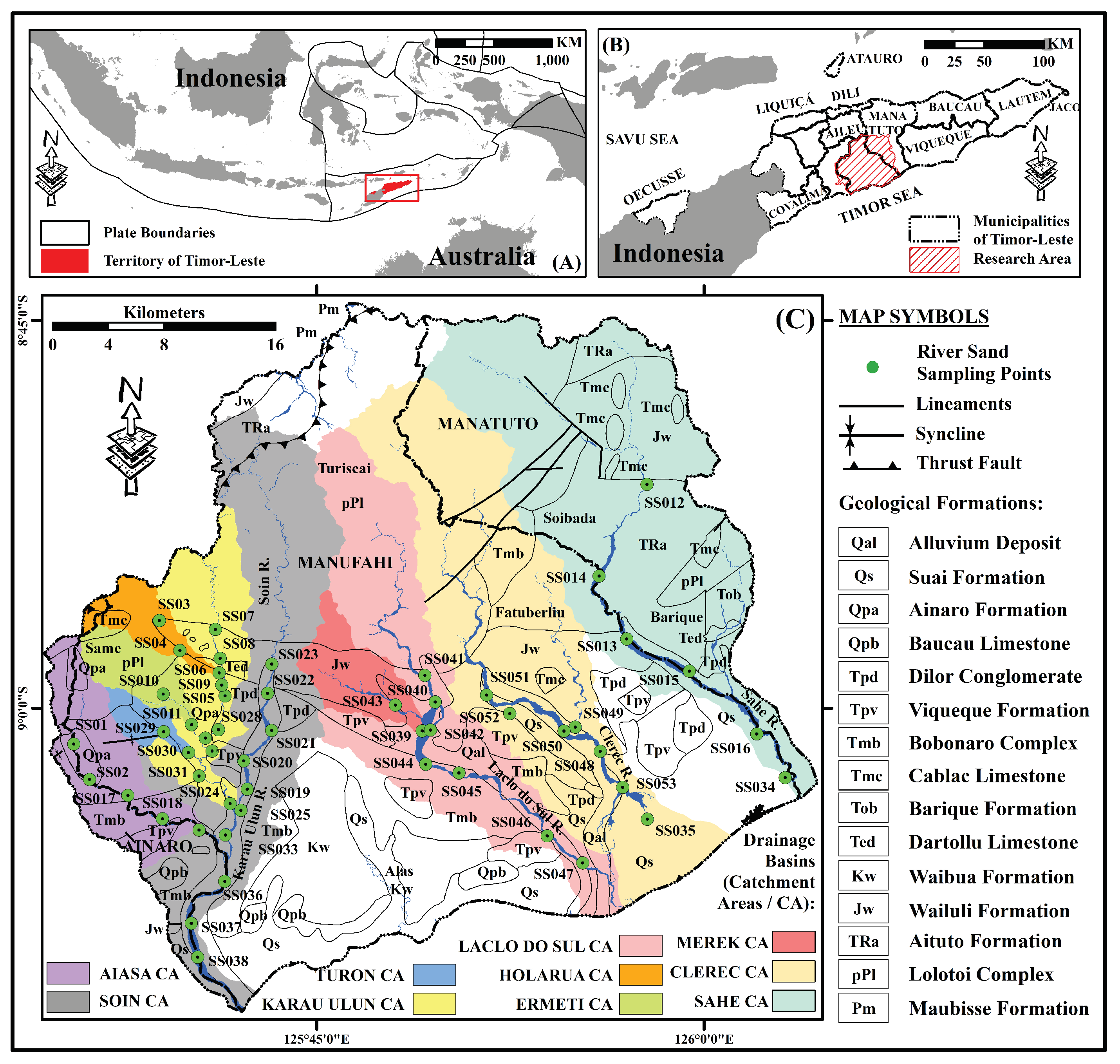
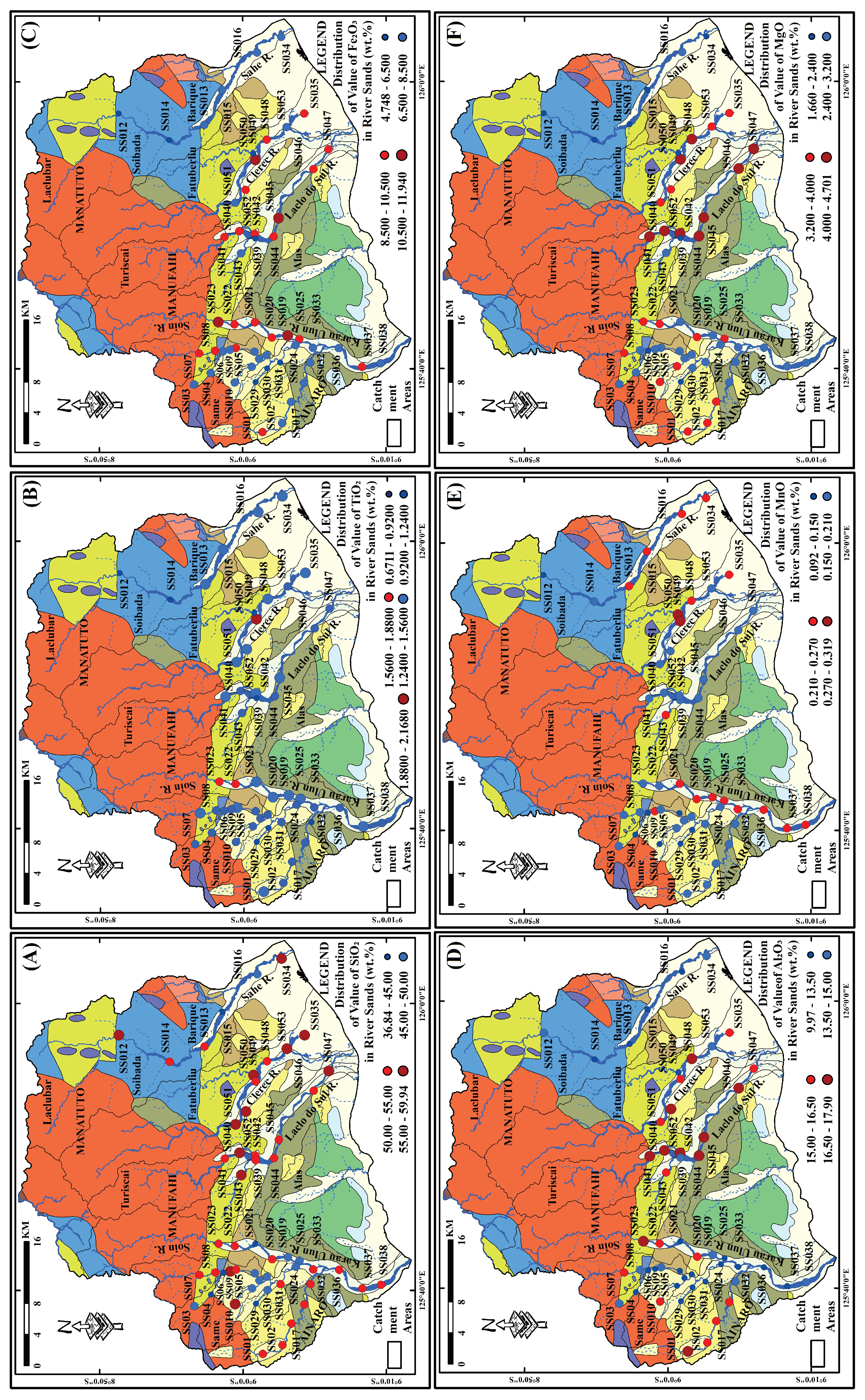
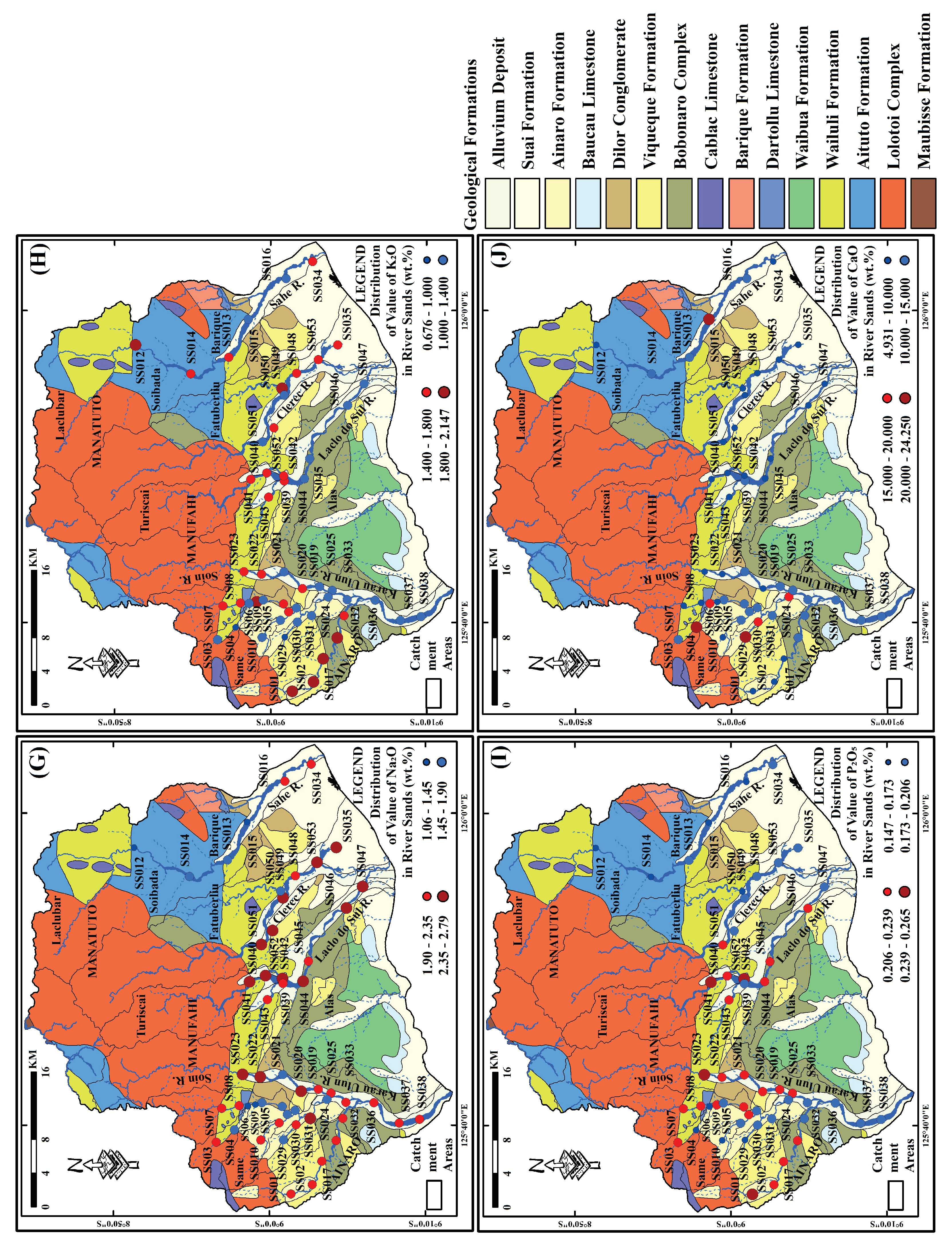

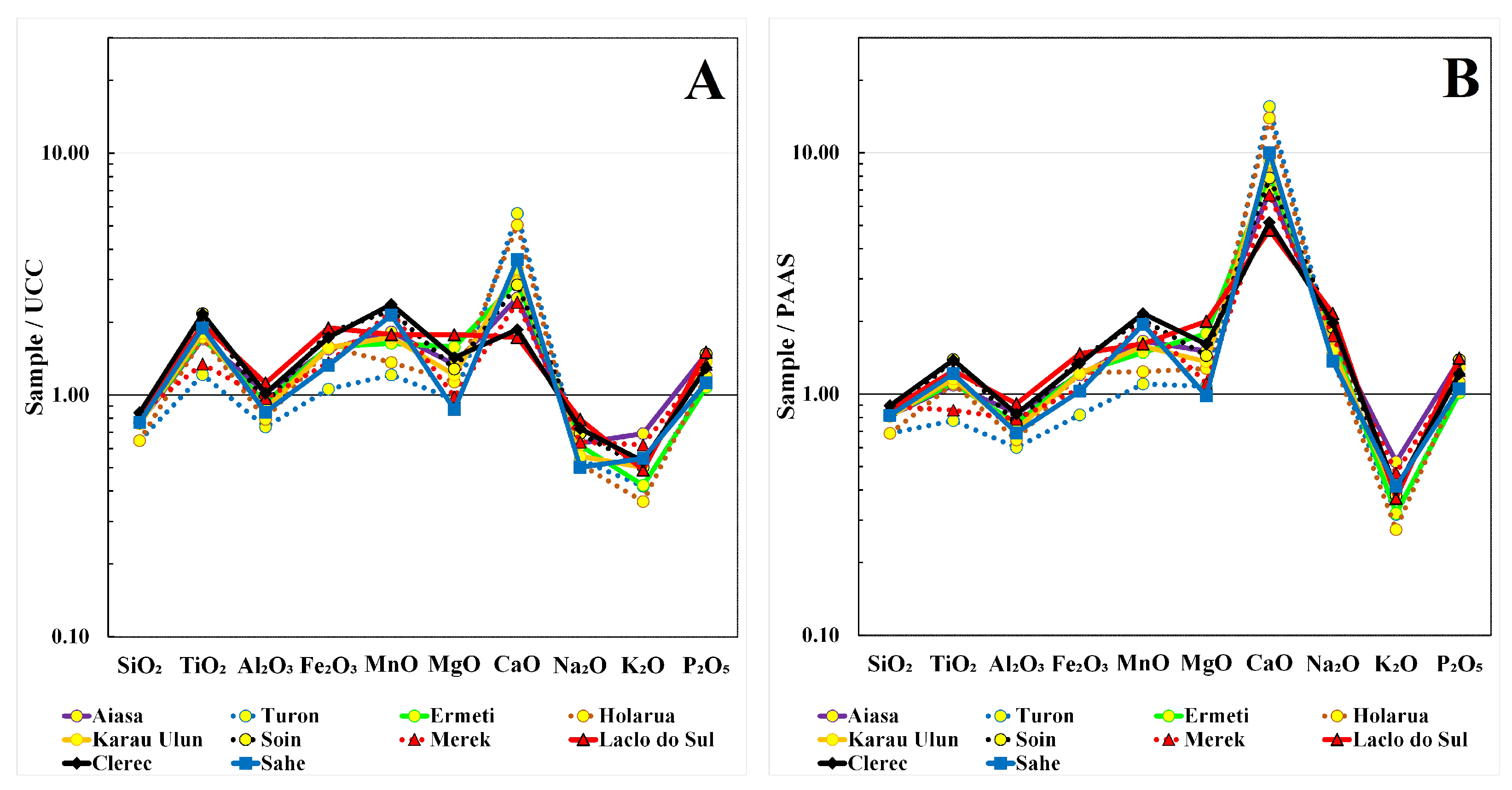
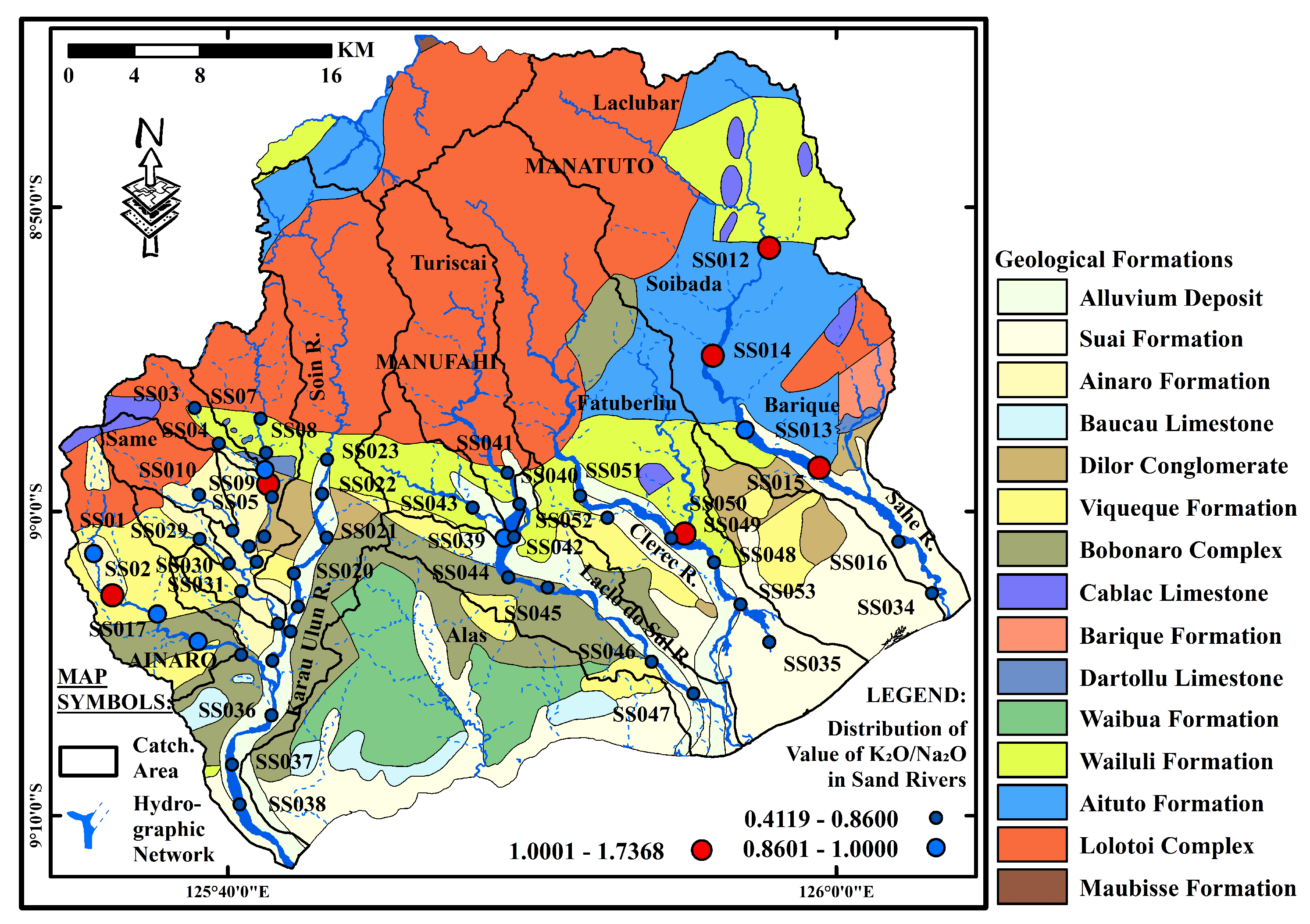
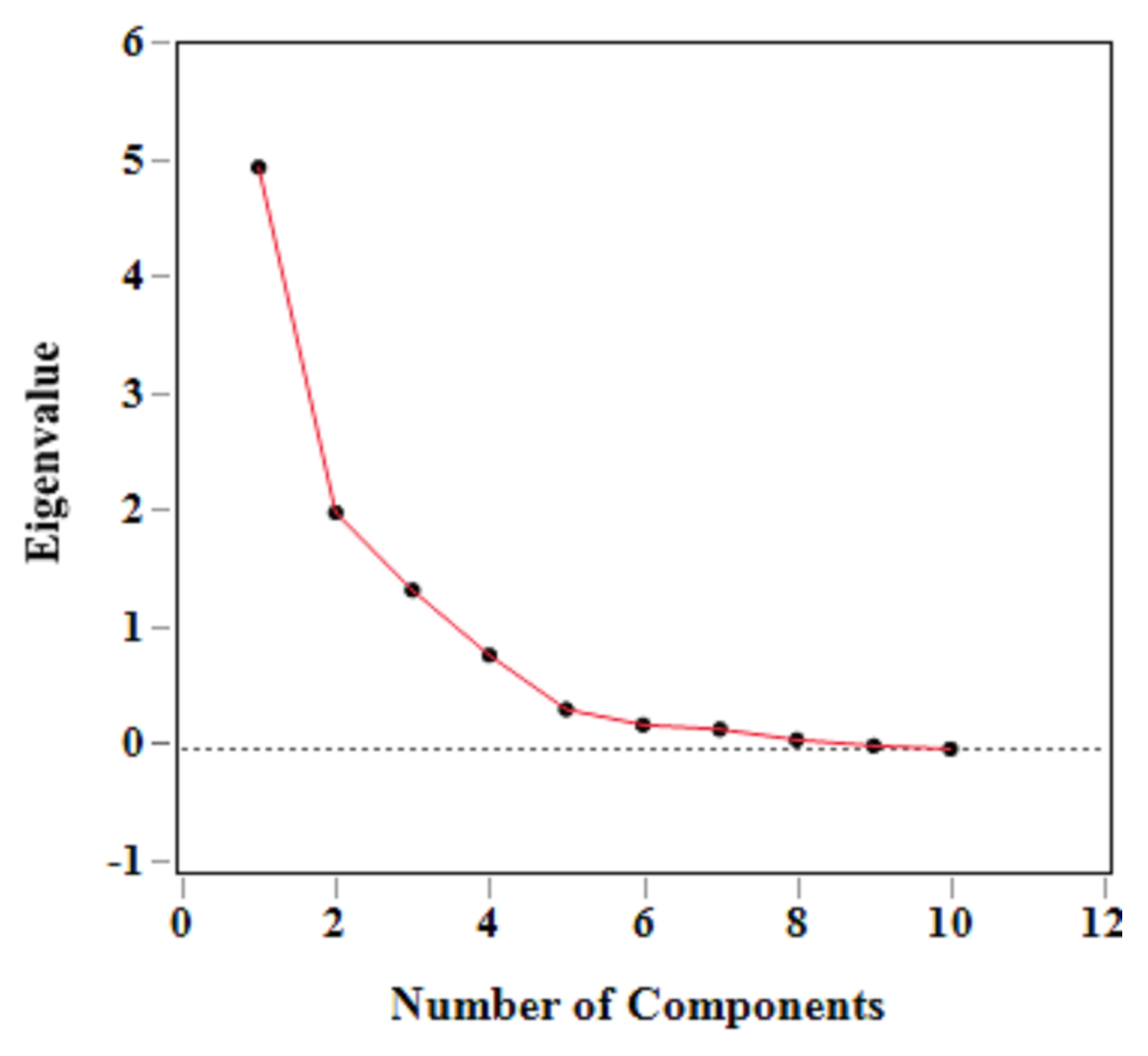
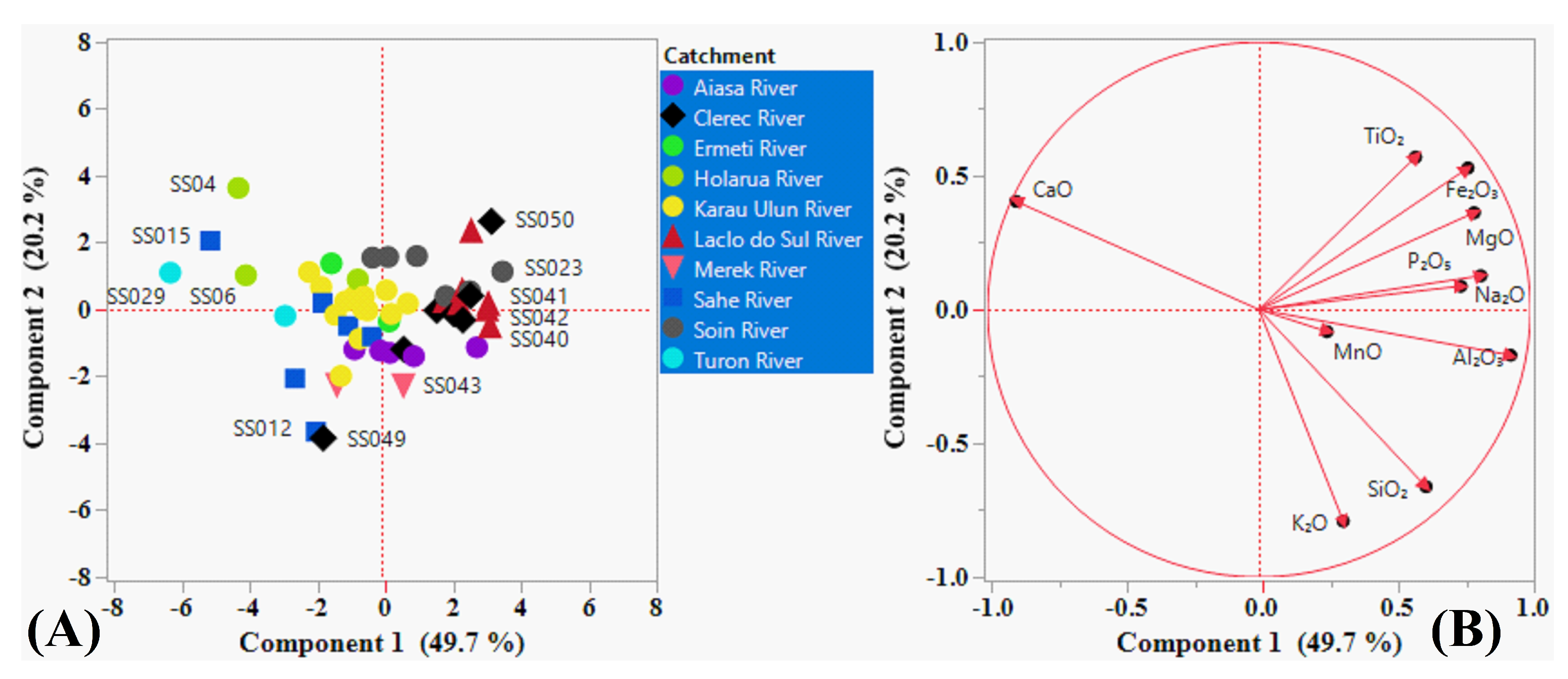
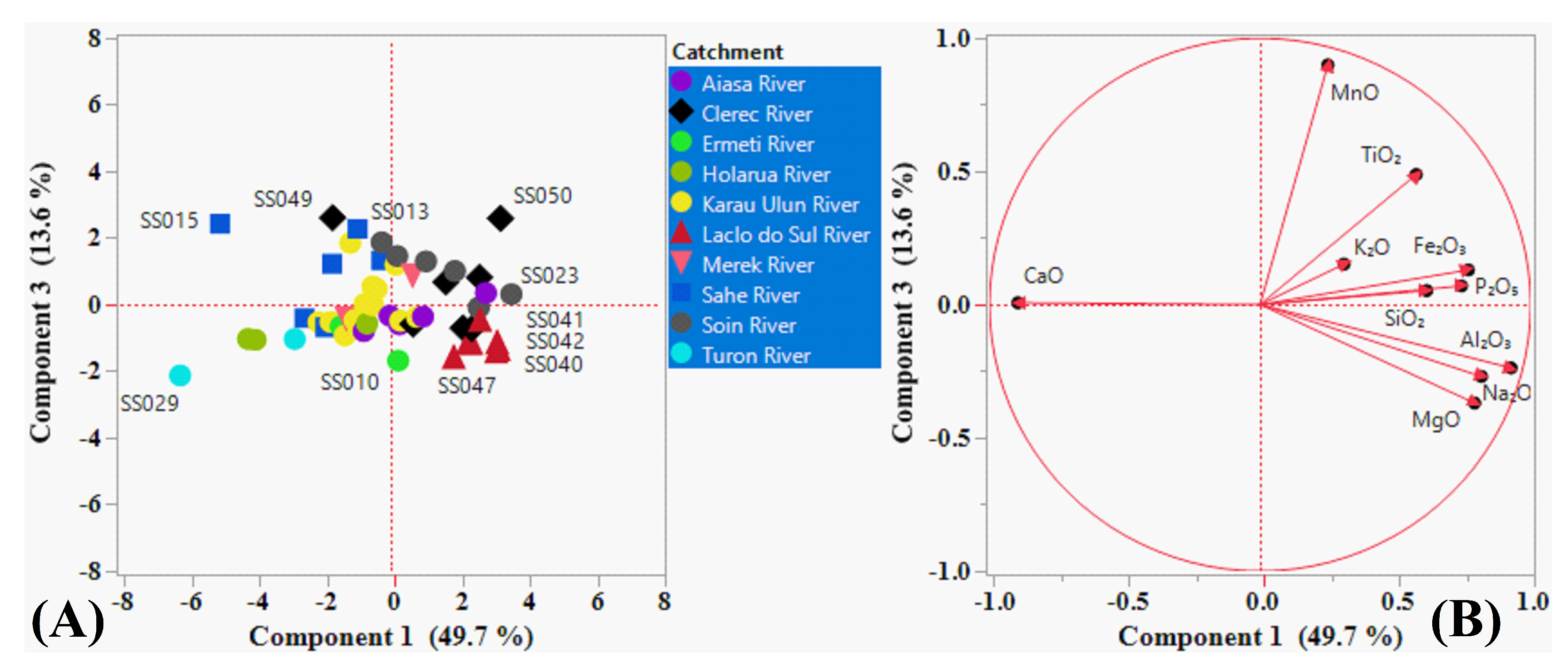
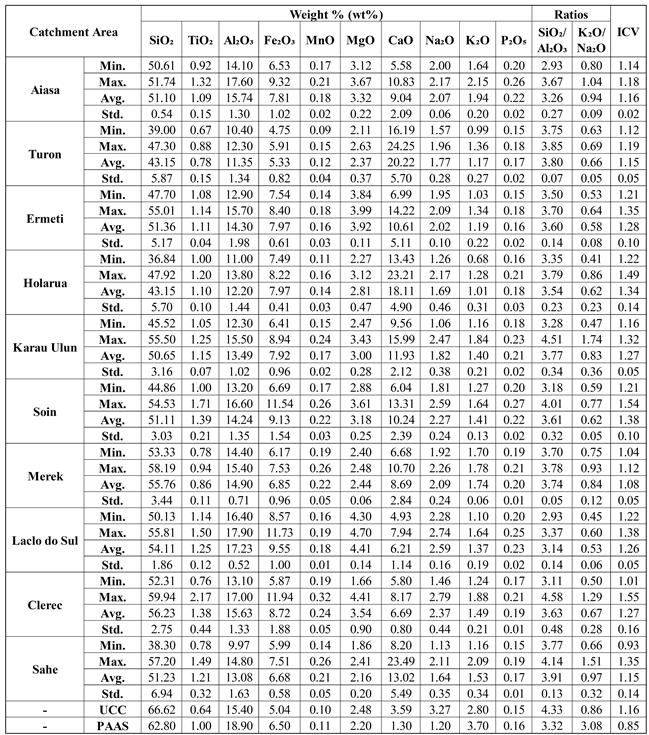 |
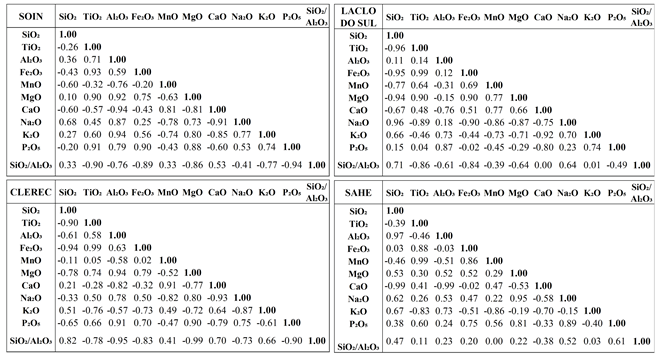 |
Disclaimer/Publisher’s Note: The statements, opinions and data contained in all publications are solely those of the individual author(s) and contributor(s) and not of MDPI and/or the editor(s). MDPI and/or the editor(s) disclaim responsibility for any injury to people or property resulting from any ideas, methods, instructions or products referred to in the content. |
© 2024 by the authors. Licensee MDPI, Basel, Switzerland. This article is an open access article distributed under the terms and conditions of the Creative Commons Attribution (CC BY) license (http://creativecommons.org/licenses/by/4.0/).





